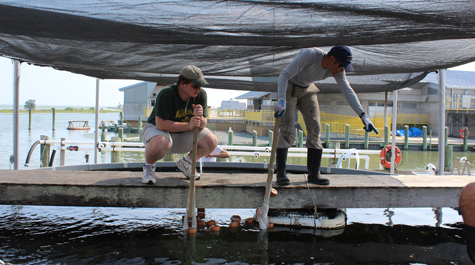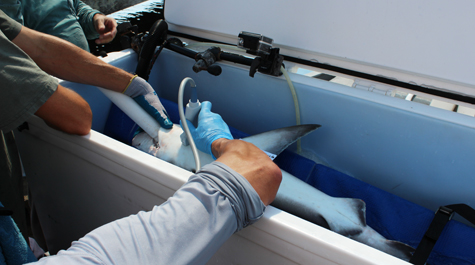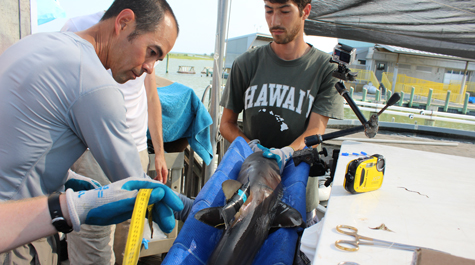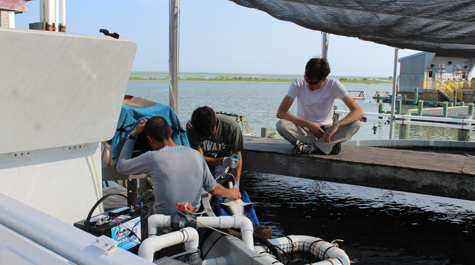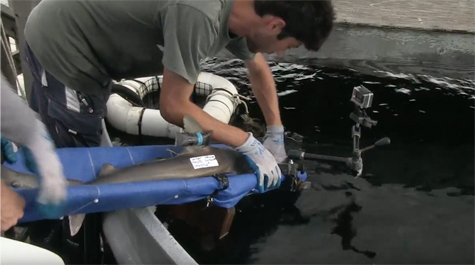Decoding sharks
Typically, the only activity that concerns beachgoers when it comes to sharks is the sight of a dorsal fin slicing through the water’s surface. But, for Kevin Weng, assistant professor of fisheries science at William & Mary’s Virginia Institute of Marine Science, what’s most interesting are the mundane actions that happen below the surface.
“Very little is known about the biology of sharks out in the wild,” said Weng. “With terrestrial animals, you can watch them with binoculars over the course of months and understand things like when they eat and what they eat. But when you release an animal back in the ocean, it’s gone. If we were able to actually measure the animal’s heart rate and activity in its natural habitat over a period of days, weeks, or even months, we’d be able to understand cycles like feeding and sleep much better.”
Weng spent the summer at the VIMS Eastern Shore Lab in Wachapreague testing two innovative methods for measuring sharks’ heart rate and movement — the latter with help from physics major William Laney ’18 and computer science major Ben Powell ’18, who provided the hardware and data expertise that tracked the shark’s acceleration underwater. While this isn’t the first time sharks have inhabited the lab’s tanks, it was a summer of firsts in shark research.
“The technique for the heart rate monitoring is actually quite new and has been demonstrated to be successful in fish but not in sharks,” Weng said. “What’s really novel about the accelerometer is that we had undergraduates custom build the tag for us.”
{{youtube:medium:left|lMoYGaeuXew, From Small Hall to the Eastern Shore}}
Excelling in accelerometry
As many great ideas do, Weng’s collaboration with Laney and Powell stemmed from a visit to the Small Hall Makerspace.
“What Kevin was struggling with is that the accelerometer tags that are commercially available are very expensive, and many are not rechargeable, so you use them once and that’s it,” said Wouter Deconinck, W&M assistant professor of physics and co-founder of the Makerspace. “What William was able to do was make the tag out of off-the-shelf components that are now available because of this maker movement that’s happening, which made it a lot cheaper.”
Deconinck estimated the accelerometers would cost between $150 and $200 (compared to the commercial tags, which run upwards of $2,000). Their self-designed, customized tag is actually a series of stacked boards smaller than a credit card, each layer designed by Laney to serve a different purpose and then programmed by Powell to optimize code and extend battery life. Once constructed, the tag and battery were tucked inside waterproof shrink-wrap tubing and secured to the shark’s dorsal fin. The sharks were then let loose in a large outdoor tank on the deck of the lab.
“We’re not just measuring the acceleration from left, right, forward, backward, up and down, we’re also measuring roll, pitch and yaw, as well as the temperature and the water pressure so we can deduce the depth of the shark,” said Deconinck. “These are all important variables in trying to understand what’s happening to a shark.”
Another component Weng hopes to someday add to the tags is an oxygen sensor, something that isn’t yet available commercially on accelerometer tags.
“That would tell us a lot about how animals are using the environment,” Weng said. “In the Chesapeake Bay, for instance, there are places with high oxygen and places with really low oxygen levels. It’s very dynamic. And obviously, since fish derive their oxygen out of the water, if you have an area with low oxygen it could affect their activity. So that’s something William is looking into.”
Back in Small Hall, Deconinck is also exploring the possibility of marketing the tag commercially, though, in keeping with the tradition of the Makerspace, the tag’s design would still be fair game to those interested in building off of it.
“This project shows that the Makerspace is a resource not just for students and for classroom teaching but also for research,” said Deconinck. “This is a perfect example of a project that grew completely out of the Makerspace and now it’s at a point where it could get external funding from an organization like the National Science Foundation and take on a life of its own. That wouldn’t have happened without the Makerspace.”
{{youtube:medium:left|HFcoQLm33TM, Shark research at Wachapreague}}
A beat ahead
To humans, a pulse rate might seem like the simplest vital sign you can take. On fish and sharks, it’s quite the opposite.
“We can pick up the electrical signal of the heart through the skin of a person,” said Weng. “With a fish or a shark, that’s not possible — it’s in the water, the skin is very thick, and they have scales or denticles.”
In lieu of a stethoscope, scientists have developed a way to surgically insert a small tag with pulse-measuring electrodes into the animal’s body. It’s a method that’s proven viable in free-swimming bony fishes, but not in sharks — until this summer.
“Measuring heart rate in sharks is more difficult than in bony fishes because the shark heart has a cartilage box around it and that blocks the electrical signals,” said Weng. “There’s also a difference in the configuration of all the organs and the shapes of the interior of the animal that make it more difficult in a shark, so a lot of the work that we are doing is trying to keep that tag in exactly the right position inside of the animal.”
Despite the obstacles, heart-rate measurements have been taken through surgically implanted electrodes in sharks before, but past research projects have required that the sharks be connected to a machine and immobilized in order to record results.
“You get fantastic data but you can’t put the animal back in the water and let it swim around,” said Weng. “So this is a nice next step.”
It’s an important step in particular because of the potential to dually measure heart rate and movement (through the accelerometer) on the same animal, at the same time — information that could help scientists to understand how a shark’s heart rate basically functions in comparison to other animals.
“Knowing what heart rate means in a fish is a little more complicated than in a mammal,” said Weng. “You imagine that when you need more oxygen — when you’re exercising, for example — your heart rate speeds up. But there’s two ways to increase the amount of blood flow — you pump faster or you pump bigger. Some fishes’ hearts just pump a larger volume of blood with each beat. So we need to figure out the relationship between activity level and heart rate in these animals in order to know how to interpret heart rate records.”
That’s something Weng hopes to learn more about as his research continues, with subsequent projects potentially taking measurements in a controlled natural environment, like a mesocosm, for much longer periods of time.
“If we could find a place with a good mesocosm, we could potentially be taking data for months and seeing all kinds of daily and lunar cycles,” Weng said. “So this is a great advance to be able to now measure the heart rate of a free-swimming shark, not just one that is immobilized.”















